
Of all the carnivores in Kruger Park, none fires the imagination more than the Cats. Their eyes, for a start are definitely the eyes of a killer. Their litheness suggests an in-escapable speed. Their teeth suggest a certain finality about the business of being a Cat.
They awaken in us an ancestral terror - and the fact that we are now masters of the world does not diminish that terror.
Above: Evening dinner
The Main Cat Predators
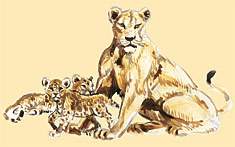 Lion (Panthera leo)
Lion (Panthera leo)
Favoured prey
Wildebeest, buffalo, giraffe, zebra, porcupines and warthogs
Hunting techniques
Hunt collectively and individually; one animal sets up the charge and drives the prey towards other members of the pride, which then pull off the ambush; lions are also effective scavengers.
Habitat
Woodland and open savanna.
Where best to see them in Kruger
Central Kruger around Satara, also around Skukuza, Lower Sabie and Crocodile Bridge
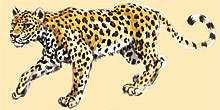 Leopard (Panthera pardus)
Leopard (Panthera pardus)
Favoured prey
Impala, bushbuck, reedbuck, waterbuck, monkeys, jackals, francolins, snakes and insects.
Hunting techniques
Hunts mostly at night although leopards will seize any opportunity for a kill; solitary hunter; drags its prey into trees.
Habitat
Riverine forest and rocky outcrops.
Where best to see them in Kruger
Riverine forest throughout the Park; highest populations are along the Sabie River, also sometimes on rocky outcrops.
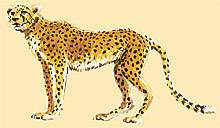 Cheetah (Acinonyx jubatus)
Cheetah (Acinonyx jubatus)
Favoured prey
Impala, kudu, waterbuck and reedbuck.
Hunting techniques
Stalks its prey to within a short distance, and then charges at it, using its advantage of speed; eats quickly because it cannot guard carcass against scavengers.
Habitat
Open grassland, savanna.
Where best to see them in Kruger
Mostly open savanna woodland in central Kruger, also common around Lower Sabie and Crocodile River in the south
Other Feline Predators
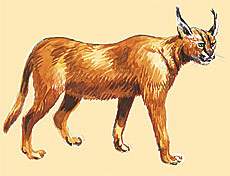 Caracal (Felis caracal)
Caracal (Felis caracal)
Characteristics
Reddish-brown, robust cats with distinctive long tufts of dark hair on their pointed ears; eyes are bright yellow; mostly solitary animals hunting at night.
Food
Preys on small animals, particularly rodents and dassies, hares, small antelope, occasionally birds and lizards.
Where best to see them in Kruger
Variety of habitats but prefers open savanna where there are rocky outcrops.
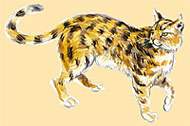 African Wild Cat (Felis lybica)
African Wild Cat (Felis lybica)
Characteristics
Similar in appearance to domestic cat but more robust; shy, nocturnal animals.
Food
The young of small antelope, rodents, hares, birds, small reptiles, insects.
Where best to see them in Kruger
Dense bush and long grass throughout Kruger.
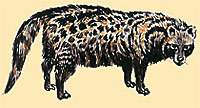 African Civet (Viverra civetta)
African Civet (Viverra civetta)
Characteristics
Cat-like animal with shaggy coat with a distinctive black band across face and throat; base colour varies from white to grey. They are solitary and nocturnal, lying in thick grass during the day.
Food
Wide variety of foods including carrion, rodents, reptiles, birds, insects, millipedes, eggs and wild fruit and berries; food choice is determined by availability and changes with the seasons.
Where best to see them in Kruger
Found in mixed woodlands in drier areas of Kruger; best chance of seeing them is on a night drive.
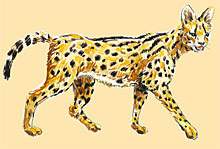 Serval (Felis serval)
Serval (Felis serval)
Characteristics
An elegant, slender, tawny, yellow-spotted cat with long legs, small head and large ears; nocturnal; by day lies in tall grass or reeds.
Food
Mainly mice and rats and, to a much lesser degree, birds, reptiles and insects.
Where best to see them in Kruger
Thick riverine bush along most of Kruger's rivers..
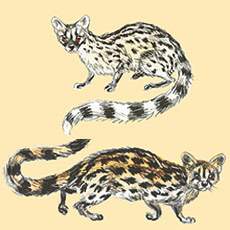 Small-spotted Genet (Genetta genetta)
Small-spotted Genet (Genetta genetta)
Large-spotted Genet (Genetta tigrina)
Characteristics
Both species of genet are found in the area; both are nocturnal hunters and agile tree climbers; the species are very similar in every respect; the most obvious distinguishing feature is that the tip of the tail of the small-spotted genet is white, while that of the large-spotted genet is usually black; contrary to popular belief, these are not cats.
Food
Both species have a very similar diet consisting predominantly of insects, rodents, birds and spiders but including reptiles, amphibians, millipedes and wild fruits; in proximity to human habitation they are a real threat to poultry.
Where best to see them in Kruger
Both species are found mostly in southern Kruger - night drives are the best opportunity for seeing them.
Illustration: Chip Snaddon

 These carniorous cats (Panthera) are extremely agile mammals and all live within a social hierarchy. Dominant males have breeding rights and...
These carniorous cats (Panthera) are extremely agile mammals and all live within a social hierarchy. Dominant males have breeding rights and...